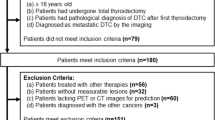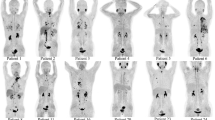Abstract
Purpose
We aimed to develop and validate a simplified, novel quantification method for radioiodine whole-body scans (WBSs) as a predictor for the treatment response in differentiated thyroid carcinoma (DTC) patients with distant metastasis.
Methods
We retrospectively reviewed serial WBSs after radioiodine treatment from 2008 to 2011 in patients with metastatic DTC. For standardization of TSH simulation, only a subset of patients whose TSH level was fully enhanced (TSH > 80 mU/l) was enrolled. The radioiodine scan index (RSI) was calculated by the ratio of tumor-to-brain uptake. We compared correlations between the RSI and TSH-stimulated serum thyroglobulin (TSH_s_Tg) level and between the RSI and Tg reduction rate of consecutive radioiodine treatments.
Results
A total of 30 rounds of radioiodine treatment for 15 patients were eligible. Tumor histology was 11 papillary and 4 follicular subtypes. The TSH_s_Tg level was mean 980 ng/ml (range, 0.5–11,244). The Tg reduction rate after treatment was a mean of −7 % (range, −90 %–210 %). Mean RSI was 3.02 (range, 0.40–10.97). RSI was positively correlated with the TSH_s_Tg level (R2 = 0.3084, p = 0.001) and negatively correlated with the Tg reduction rate (R2 = 0.2993, p = 0.037). The regression equation to predict treatment response was as follows: Tg reduction rate = −14.581 × RSI + 51.183.
Conclusions
Use of the radioiodine scan index derived from conventional WBS is feasible to reflect the serum Tg level in patients with metastatic DTC, and it may be useful for predicting the biologic treatment response after radioiodine treatment.




Similar content being viewed by others
References
Cho BY, Choi HS, Park YJ, Lim JA, Ahn HY, Lee EK, et al. Changes in the clinicopathological characteristics and outcomes of thyroid cancer in Korea over the past four decades. Thyroid. 2013;23:797–804.
Siegel R, Naishadham D, Jemal A. Cancer statistics, 2013. CA Cancer J Clin. 2013;63:11–30.
Chen AY, Jemal A, Ward EM. Increasing incidence of differentiated thyroid cancer in the United States, 1988–2005. Cancer. 2009;115:3801–7.
Durante C, Haddy N, Baudin E, Leboulleux S, Hartl D, Travagli JP, et al. Long-term outcome of 444 patients with distant metastases from papillary and follicular thyroid carcinoma: benefits and limits of radioiodine therapy. J Clin Endocrinol Metab. 2006;91:2892–9.
Jonklaas J, Sarlis NJ, Litofsky D, Ain KB, Bigos ST, Brierley JD, et al. Outcomes of patients with differentiated thyroid carcinoma following initial therapy. Thyroid. 2006;16:1229–42.
Wada N, Nakayama H, Suganuma N, Masudo Y, Rino Y, Masuda M, et al. Prognostic value of the sixth edition AJCC/UICC TNM classification for differentiated thyroid carcinoma with extrathyroid extension. J Clin Endocrinol Metab. 2007;92:215–8.
Cooper DS, Doherty GM, Haugen BR, Kloos RT, Lee SL, Mandel SJ, et al. Revised American Thyroid Association management guidelines for patients with thyroid nodules and differentiated thyroid cancer. Thyroid. 2009;19:1167–214.
Kim DH, Jung JH, Son SH, Kim CY, Hong CM, Jeong SY, et al. Difference of clinical and radiological characteristics according to radioiodine avidity in pulmonary metastases of differentiated thyroid cancer. Nucl Med Mol Imaging. 2014;48:55–62.
Min JJ, Chung JK, Lee YJ, Jeong JM, Lee DS, Jang JJ, et al. Relationship between expression of the sodium/iodide symporter and 131I uptake in recurrent lesions of differentiated thyroid carcinoma. Eur J Nucl Med. 2001;28:639–45.
Hanscheid H, Lassmann M, Luster M, Thomas SR, Pacini F, Ceccarelli C, et al. Iodine biokinetics and dosimetry in radioiodine therapy of thyroid cancer: procedures and results of a prospective international controlled study of ablation after rhTSH or hormone withdrawal. J Nucl Med. 2006;47:648–54.
Ahn BC, Lee WK, Jeong SY, Lee SW, Lee J. Estimation of true serum thyroglobulin concentration using simultaneous measurement of serum antithyroglobulin antibody. Int J Endocrinol. 2013;2013:210639.
Johansen K, Woodhouse NJ. Comparison of thyroglobulin and radioiodine scintigraphy during follow-up of patients with differentiated thyroid carcinoma. Eur J Med. 1992;1:403–6.
Ma C, Kuang A, Xie J, Ma T. Possible explanations for patients with discordant findings of serum thyroglobulin and 131I whole-body scanning. J Nucl Med. 2005;46:1473–80.
Kim HJ, Lee JI, Kim NK, Min YK, Kim SW, Chung JH. Prognostic implications of radioiodine avidity and serum thyroglobulin in differentiated thyroid carcinoma with distant metastasis. World J Surg. 2013;37:2845–52.
Bernier MO, Leenhardt L, Hoang C, Aurengo A, Mary JY, Menegaux F, et al. Survival and therapeutic modalities in patients with bone metastases of differentiated thyroid carcinomas. J Clin Endocrinol Metab. 2001;86:1568–73.
Casara D, Rubello D, Saladini G, Masarotto G, Favero A, Girelli ME, et al. Different features of pulmonary metastases in differentiated thyroid cancer: natural history and multivariate statistical analysis of prognostic variables. J Nucl Med. 1993;34:1626–31.
Lassmann M, Hanscheid H, Verburg FA, Luster M. The use of dosimetry in the treatment of differentiated thyroid cancer. Q J Nucl Med Mol Imaging. 2011;55:107–15.
Luster M, Hanscheid H, Freudenberg LS, Verburg FA. Radioiodine therapy of metastatic lesions of differentiated thyroid cancer. J Endocrinol Invest. 2012;35:21–9.
Lind P, Kohlfurst S. Respective roles of thyroglobulin, radioiodine imaging, and positron emission tomography in the assessment of thyroid cancer. Semin Nucl Med. 2006;36:194–205.
Karam M, Gianoukakis A, Feustel PJ, Cheema A, Postal ES, Cooper JA. Influence of diagnostic and therapeutic doses on thyroid remnant ablation rates. Nucl Med Commun. 2003;24:489–95.
Salvatori M, Raffaelli M, Castaldi P, Treglia G, Rufini V, Perotti G, et al. Evaluation of the surgical completeness after total thyroidectomy for differentiated thyroid carcinoma. Eur J Surg Oncol. 2007;33:648–54.
Rosario PW, Maia FF, Cardoso LD, Barroso A, Rezende L, Padrao EL, et al. Correlation between cervical uptake and results of postsurgical radioiodine ablation in patients with thyroid carcinoma. Clin Nucl Med. 2004;29:358–61.
Im HJ, do Koo H, Paeng JC, Lee KE, Chung YS, Lim I, et al. Evaluation of surgical completeness in endoscopic thyroidectomy compared with open thyroidectomy with regard to remnant ablation. Clin Nucl Med. 2012;37:148–51.
Hurst EW, Davies OL. Studies on the blood–brain barrier. II. Attempts to influence the passage of substances into the brain. Br J Pharmacol Chemother. 1950;5:147–64.
Misaki T, Iwata M, Kasagi K, Konishi J. Brain metastasis from differentiated thyroid cancer in patients treated with radioiodine for bone and lung lesions. Ann Nucl Med. 2000;14:111–4.
Ahn BC, Seo JH, Bae JH, Jeong SY, Yoo J, Jung JH, et al. Effects of anti-thyroglobulin antibody on the measurement of thyroglobulin: differences between immunoradiometric assay kits available. Nucl Med Mol Imaging. 2005;39:252–6.
Furhang EE, Larson SM, Buranapong P, Humm JL. Thyroid cancer dosimetry using clearance fitting. J Nucl Med. 1999;40:131–6.
Tabei F, Neshandar Asli I, Azizmohammadi Z, Javadi H, Assadi M. Assessment of radioiodine clearance in patients with differentiated thyroid cancer. Radiat Prot Dosimetry. 2012;152:323–7.
Torrens JI, Burch HB. Serum thyroglobulin measurement. Utility in clinical practice. Endocrinol Metab Clin N Am. 2001;30:429–67.
Disclosure
Conflict of interest
Jong-Ryool Oh, Byeong-Cheol Ahn, Shin Young Jeong, Sang-Woo Lee and Jaetae Lee declare that they have no conflict of interest.
Informed Consent
All procedures followed were in accordance with the ethical standards of the responsible committee on human experimentation and with the Helsinki Declaration of 1975, as revised in 2000. Informed consent was obtained from all patients for being included in the study. Additional informed consent was obtained from all patients for which identifying information is included in this article.
Author information
Authors and Affiliations
Corresponding author
Rights and permissions
About this article
Cite this article
Oh, JR., Ahn, BC., Jeong, S.Y. et al. Radioiodine Scan Index: A Simplified, Quantitative Treatment Response Parameter for Metastatic Thyroid Carcinoma. Nucl Med Mol Imaging 49, 174–181 (2015). https://doi.org/10.1007/s13139-015-0335-3
Received:
Revised:
Accepted:
Published:
Issue Date:
DOI: https://doi.org/10.1007/s13139-015-0335-3




